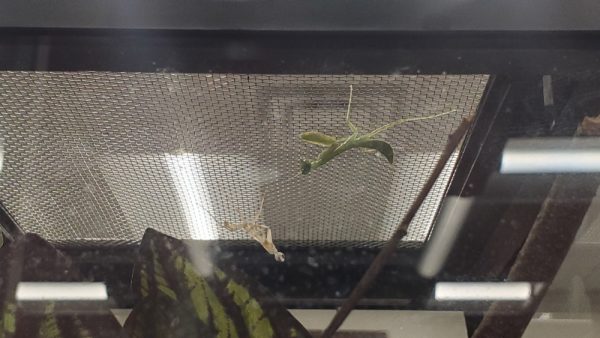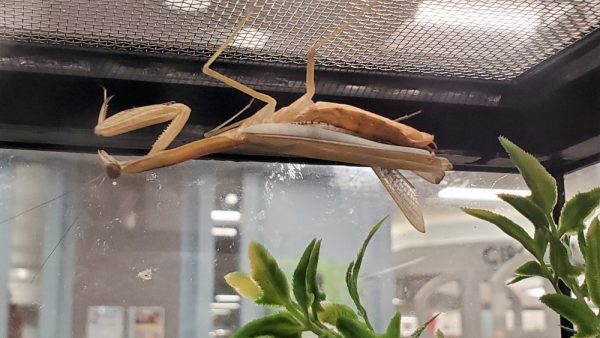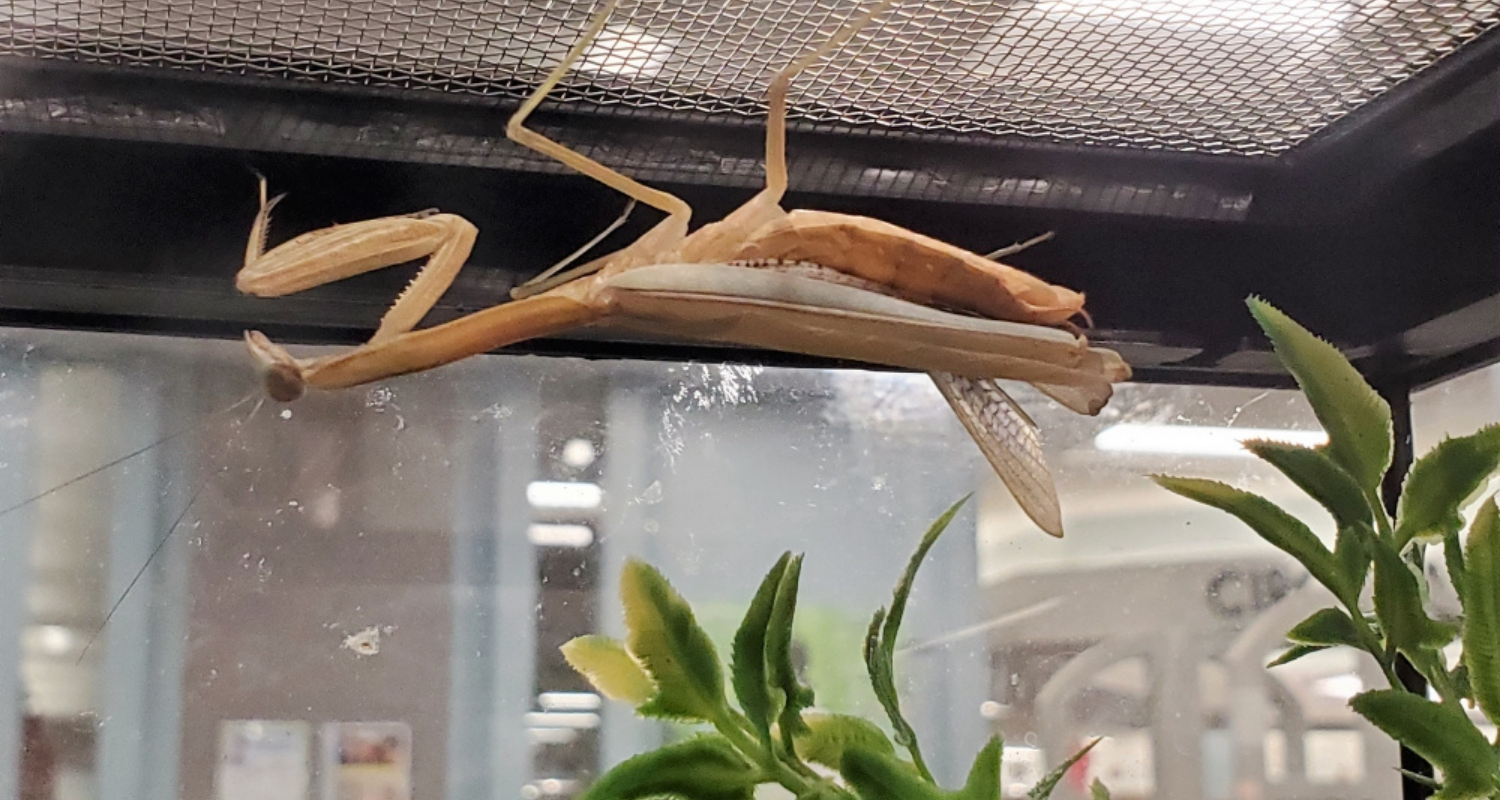Over the summer, Sean Duffy of the Ohio County Public Library put together a program to celebrate insects and their relationships with humans. During this program, we unveiled an ongoing event called the “Mantis Cam.” This exhibit can be viewed online 24/7, or in person during library hours, where you may see our two mantids living their best lives. If you’re interested in the inception of this program, check out this Weelunk article.
READ MORE: Bug Out at the Ohio County Public Library!
The program itself—Bugs and People—received overwhelming support. During the talk I did on mantids, for example, I was able to fill an entire hour-long event just by answering the many excellent questions that our patrons had about mantids. It was pretty incredible. Our Mantis Cam has also been quite popular; since we’ve gone live in August we have received as many as 97 unique watchers on Twitch, where we’ve also gained 89 followers.
Since then, our two mantids—Phaedra and Fi—have grown considerably. Phaedra, our Chinese mantis (Tenodera sinensis), is a full grown adult now. She has her wings now, and will no longer be molting. Fi, our California mantis (Stagmomantis californica) is not yet fully grown. He has one molt remaining before he is an adult, and we expect this to happen within the next month.
Meet Phaedra and Fi
We took submissions for a naming contest for a few weeks, starting shortly after our mantis program. We took names suggestions from patrons, which our staff voted on. The winning names were Phaedra, given to our Chinese mantis, and Fiona, which was given to our California mantis. At the time, we thought Fi was female. We learned shortly after his following molt that he was, in fact, a male.
Why the mix-up?
Fi’s species is physically distinct from Phaedra’s. He has an upturned curled abdomen, a large head, and larger than average raptorial forelimbs. He is also much smaller than Phaedra. When I counted out the segments of his abdomen—which is how you determine a mantid’s sex before they reach adulthood—the shape of his abdomen, plus his diminutive size, led me to miscount the segments. Males have eight segments on their abdomen and females have six. Fi’s segments were so thin that some appeared as one.
So now we just call him Fi, which is also short for Finbar. I personally don’t mind it when folks call him Fiona. There’s nothing wrong with a male mantis being named Fiona!
Personality and Behavior: Fi

Fi was our shyest mantis for the longest time. It took a lot of patience and waiting before he started coming out to socialize. Now we can coax him up to hang out, but he’s perfectly content within his habitat. He’s much more sedentary than Phaedra, and much more the ambush predator to boot. While Phaedra will rush down her prey, Fi is perfectly content hanging from the bottom side of a leaf that’s close to the floor of his habitat, patiently waiting for something to pass beneath him.
And though that may paint him as a patient, chilled out mantis, he’s actually a bit of a spaz. He actively hid from everyone and everything for the first week after we transplanted him into his habitat. Any efforts to interact with him, no matter how slow or gentle, would cause him to panic. If a prey animal happens to get onto the same leaf as him, he’ll practically flail around as he flees from it. So although he’s recently come out of his shell (heh), he’s still much more anxious than his otherwise relaxed demeanor lets on.
Personality and Behavior: Phaedra

Phaedra is extremely outgoing. She’s always taken to being handled, which we’ve done every day since she was old enough to be held. One of our staff members, Erin Rothenbueler, has held her the most often, sometimes having her out for an hour at a time. Phaedra will reliably hang out at Erin’s desk, hanging off of or standing on top of her computer monitor for as long as Erin will let her.
We’ve noticed a difference in Phaedra’s attitude between different staff members, too. She’s always very social, yes, but she’s pretty lackadaisical when it comes to other people. Erin, on the other hand, elicits an energetic and perked up reaction.
Phaedra is also extremely spoiled. She likes to leave her habitat every day and if she doesn’t get to leave as long as she’d prefer, she will not return to her habitat. If we tap her on the abdomen or the back of her legs to coax her back into her habitat, she will slash at whatever instrument we used to do so.
I’ve noted from personal experience that she can have an attitude towards someone, too. The best example of this was a time when I went to feed her and she was hanging from the top of her habitat. I turned over the lid, and she immediately wanted to be held, waggling her forelimbs in the direction of my hand, indicating that she wanted to be picked up. Since I had a container of crickets open, I didn’t hold her immediately and instead focused on putting her prey animals in her habitat. When I went back to hold my hand out for her, she withdrew her forelimbs and refused to climb on. She wanted absolutely nothing to do with me for the rest of the day, refusing to even climb out of her habitat for me later on. It might be too anthropomorphizing to say that I offended her, but it’s hard for me to take this any other way.
Feeling at Home at the OCPL
Our mantids are kept in special habitats that are always on display within our library and on our 24/7 Mantis Cam. These habitats contain coconut shaving substrates, plastic greenery to emulate their natural environment, and plenty of sturdy sticks that help them climb up to the top of their habitats. We mist their habitats with purified water once a day, and feed them gut-loaded crickets every afternoon. As a note for any who may want to take up this hobby as well, crickets are actually very terrible feeder insects. They’re mostly just fat and water and give very little nutrients to your pet. They’re also the most readily available feeder insect out there, though, so you need to take care of your crickets almost as much as you do your pet. Gut loading refers to the practice of feeding crickets extremely nutritious food pellets so that they may transfer the nutrition of their diet to the animal that eats them.
One of the most wonderful things to happen with our mantids is the way that Phaedra has changed her colors. For the longest time, Phaedra was a brilliant green color, matching the greenery we have in her habitat. Most mantids can change their colors as they grow, adapting to their environment in order to camouflage themselves from their prey. Their color often represents their preferred environment. A bright green mantis—such as Fi—prefers the camouflage of leaves and grass, while a dark brown mantis will prefer bark, twigs, and branches. Phaedra has changed to a light tan color. We were initially perplexed, as there is nothing in her habitat that matches her color. We then realized that, after being handled so long and so often, she has actually changed her colors to match with human skin! This is an incredible display that I’ve never seen before in the Tenodera sinensis.
[template_part type="video" title="Mantis Cam" description="Watch Fi and Phaedra on the OCPL's 24/7 Mantis Cam" url="https://youtu.be/ylcPhuYBEGs"]What’s Next?
We’ve recently acquired all the materials to construct our own bioactive vivarium. Now that it’s complete, it’s only a matter of time before we move Phaedra into it. A bioactive vivarium is a natural habitat contained within a specialized style of aquarium. Micro-animals such as spring tails and isopods (pill bugs, potato bugs, etc) live in the soil, cleaning up after messes left by the vivarium’s host animal, oxygenating the soil, and overall creating a healthy, living environment. Small plants are also planted in the soil, although ours differs in that we’re using air plants, which do not require soil and can grow from any surface.
Our vivarium is set up and our micro-animals are living their lives, but we can’t yet move Phaedra in until the humidity within the vivarium levels out. Something I did not know about living vivariums: you only need to mist them once a week! That was a shock to me. I’m so used to non-bioactive habitats, which you need to mist once a day to maintain proper humidity. We over-misted it for the first week and the humidity levels skyrocketed. Once they level back out and the habitat comes to an equilibrium, we’ll be moving Phaedra into it permanently.
Maintaining humidity in our habitats is extremely important. Every mantis species requires a different level of humidity. Luckily, the Chinese and California mantis require roughly the same levels. If their environment isn’t humid enough, they have a harder time molting. If their environment is too humid, they’ll fall prey to bacterial and fungal infections.
A little about molting: a mantis, after climbing out of an ooth, will molt anywhere between six to eight times, depending on their species. This happens when their internal mass begins to exceed their exoskeleton, at which point they must shed their old exoskeleton for a larger one. As of their final molt, they become fully grown adults, grow their wings, and become capable of mating.
For Phaedra, the most difficult thing she has to look forward to is laying an ootheca, a protective mass that conceals her eggs. Females lay an ooth whether their eggs are fertilized or not, and the process can be about as difficult as a full molt. If something goes wrong, some of the ooth will remain backed up in her abdomen, causing major digestive issues. It’s up to us to keep her habitat at a proper level of humidity so the process is as easy for her as possible.
Fi, on the other hand, has one more molt remaining. As discussed earlier, we expect this to happen within the month of October. Once this is complete, he’ll have his wings. This might present us with a small problem, though! You see, Fi is a California mantis. The California mantis is one of the best fliers of them all, so we’ll need to take care when handling him.
Phaedra and Fi are incompatible with each other, so we will not be attempting to mate them. Coming from entirely different species, they are not capable of interbreeding. In fact, we have a screen between their habitats so they cannot see each other. Fi is as small as he is skittish. If he saw this giant of a female every day of his life, he’d be even more of an anxious mess than he is today.
We plan to continue sharing Phaedra and Fi with our patrons and our community. They provide great opportunities to teach our patrons a little bit about something that they might have never known. They’re also extremely popular with the children of our patrons, who often want to hear more about them, handle them, and have plenty of questions that we mostly have the answers to.
Come next year, when Phaedra and Fi are no longer with us (they only have a lifespan of a year, sadly), we intend to move on to a more exotic species. Tenodera sinensis (and Stagmomantis californica, by happy accident) was always meant to be a test run for this program, just to see if we’d generate enough patron interest to invest in exotics. I can confidently say that the interest is there, and we’ll be continuing this program for the community to enjoy.
Want to learn more about mantises? The library has several hard-copy books that you can check out when you visit the library, you can also find several ebooks online through Hoopla.
• Nayt Knapp is a Wheeling area native and reference assistant at the Ohio County Public Library. He is a graduate from West Liberty University with a Bachelors in English and a minor in writing. Nayt spends most of his time reading, researching, writing, or playing games (of both the video and tabletop varieties) with friends. His interests lie in science fiction, fantasy, entomology (mantids especially!), fiction writing, and the design, development, and writing of tabletop roleplaying games.


